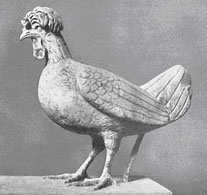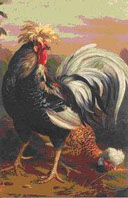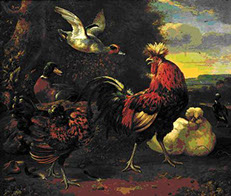Feathers - Jurrasic, Natural Selection, Sexual Selection, Aerodynamics.
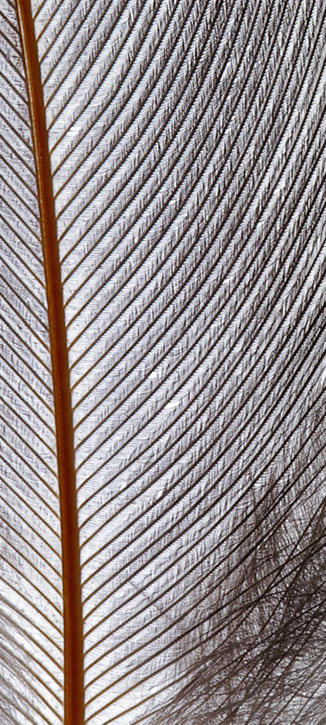
Ulf Skogsberg
email:![]()
Photography
After contemplating a feather and examining it under enlargement - fascination turns into a need to depict and show this marvel of nature's engineering and the feather's obvious aesthetic qualities. Two factors are paramount; exacting micro photography at extreme high resolution and large prints to show the exquisite detail. The methods are found in technologies of today, bringing together digital capture, astronomy photography focus stacking and panorama stitching software technology, together with contemporary printing technology with multiple pigments and archival cotton based paper. These techniques allow for making photography and prints that allow the viewer to see more in a photographic print than ever before. More details, more tones, more colors...
A website cannot show these qualities - better to see the prints in person.
However, electronic versions are posted on this website under the Link on this page "Feather Gallery"
For more information or to drop me a line with a comment or request;
Rooster in our yard
A Rooster appears in our yard, "Gallus Gallus" - a common chicken ?
Not so common... a Breed now coveted mostly as Show Birds; "Padovano" or "Paduan" named for Padua Italy, where this rooster reigns as the city weapon or "Polish", as the English calls them or "Ciuffata" named by the Dutch.
We allow him to stay or to leave... whatever he wishes, give food water shelter. he loves being photographed, when no owners found he gets a few female friends - start of a flock that quickly grows - new blood brought in - coops built - veterinary skills learned - egg production - art work - inspiration....
My wife and collaborator; artist Hope Sandrow has a project "Open Air Studio" that encompasses the Paduan Chickens and more - read about it here...
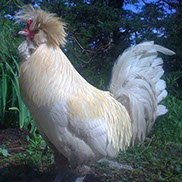
Feathers
Feather:, a marvel of Genetic instruction to create insulation, aerodynamic foils for flying and patterns for displaying quality of health and genetics to the opposite sex.
According to Darwin:
"Natural Selection" - genetics inherited from the survivors...
an example is getting away from a predator by flying off...
"Sexual Selection" - genetic quality display to be chosen to procreate...
an example is the patterns and shapes of the feathers...
Feathers are very complex - their construction, purpose, history - 160 Billion years....

Pennaceous Feathers (the vaned feathers) have recently been discovered to have tiny nano-sized receptors, that are designed to capture air or water molecules. Thus the feathers carry a layer of air, to glide better - or to hold droplets of water away from the feather, which makes it water proof. So the duck relies not on oil, but on nano technology to stay dry.
Feather construction
Feathers are one of the epidermal growths that form the distinctive outer covering, or plumage, on birds and some non-avian theropod dinosaurs. They are considered the most complex integumentary structures (tough outer protective layer) found in vertebrates, and indeed a premier example of a complex evolutionary model. They are among the characteristics that distinguish the extant Aves from other living groups. Feathers have also been noticed in those Theropoda which have been termed "feathered dinosaurs". Although feathers cover most parts of the body of birds, they arise only from certain well-defined tracts on the skin. They aid in flight, thermal insulation, waterproofing, pattern and coloration that helps in communication and protection, as well as to attract a mate.
Sexual selection
Sexual selection, a concept introduced by Charles Darwin in his 1859 book "On the Origin of Species", is a significant element of his theory of natural selection. The sexual form of selection;
... depends, not on a struggle for existence, but on a struggle between the males for possession of the females; the result is not death to the unsuccessful competitor, but few or no offspring.
... when the males and females of any animal have the same general habits ... but differ in structure, colour, or ornament, such differences have been mainly caused by sexual selection.
The coloration of feathers is believed to be primarily evolved in response to sexual selection. In many cases the physiological condition of the birds is indicated by the quality of their feathers and this is used, mainly by the females, in mate choice.
The females cannot be as outrageously decorated, since they cannot afford to be discovered by a predator while hatching the offspring. Nonetheless they are very beautiful and many of my feather prints are depictions of feathers from the females.
Flight
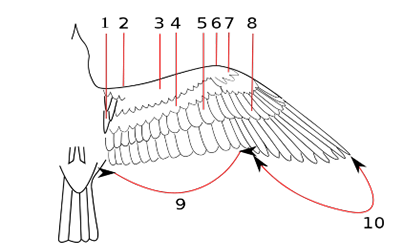
1 Axillaries
2 Margin (Marginal underwing coverts)
3 Lesser underwing coverts
4 Median underwing coverts (Secondary coverts)
5 Greater underwing coverts (Secondary coverts)
6 Carpal joint
7 Lesser underwing primary coverts
8 Greater underwing primary coverts
9 Secondaries
10 Primaries
Most paleontologists agree that birds evolved from small theropod dinosaurs, but the origin of bird flight is one of the oldest and most hotly contested debates in paleontology. The main hypotheses are: "from the trees down", that birds' ancestors first glided down from trees and then acquired other modifications that enabled true powered flight; "from the ground up", that birds' ancestors were small, fast predatory dinosaurs in which feathers developed for other reasons and then evolved further to provide first lift and then true powered flight; and "wing-assisted incline running" and "Pouncing Proavis", which posits that flight evolved by modification from arboreal ambush tactics.
Powered Flight
When a bird flaps, as opposed to gliding, its wings develops lift as with gliding, but the lift is rotated forward to provide thrust, which counteracts drag and increases its speed, which has the effect of also increasing lift to counteract its weight, allowing it to maintain height or to climb. Flapping involves two stages: the down-stroke, which provides the majority of the thrust, and the up-stroke, which can also provide some thrust. At each up-stroke the wing is slightly folded inwards to reduce the energetic cost of flapping-wing flight. Birds change the angle of attack between the up-stroke and the down-stroke of their wings. The structure of the feathers have interlocking barbules that provide stiffness for the downstroke, but gives way on the upstroke to allow air to move through the wing so as minimize drag.
Moybridge; Bird in Flight; Detail

Paleontology

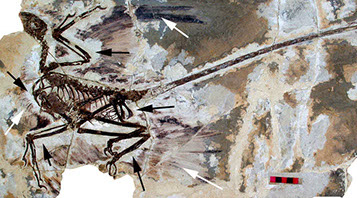
Dinosaurs are closely related to birds and there were feathered dinosaurs. Fossils of Archaeopteryx include well-preserved feathers, but it was not until the mid-1990s that clearly non-avialan dinosaur fossils were discovered with preserved feathers. Since then, more than twenty genera of dinosaurs, mostly theropods, have been discovered to have been feathered. Most fossils are from theYixian formation in China. The fossil feathers of one specimen, Shuvuuia deserti, have tested positive for beta-keratin, the main protein in bird feathers.
